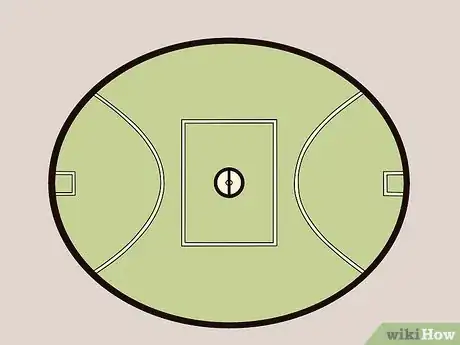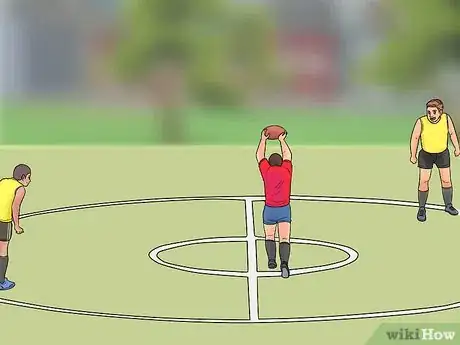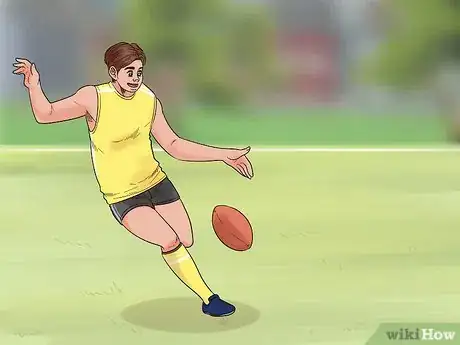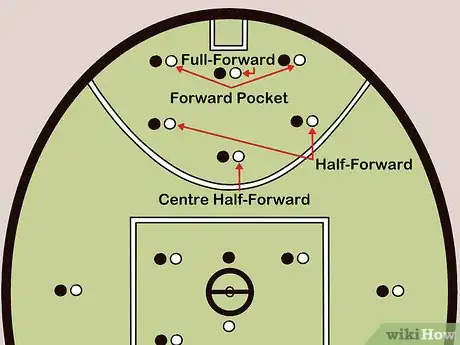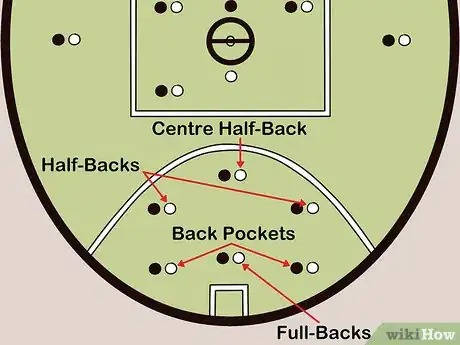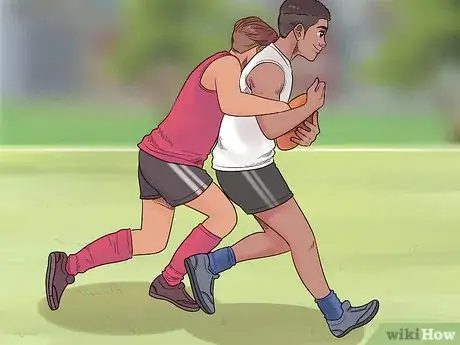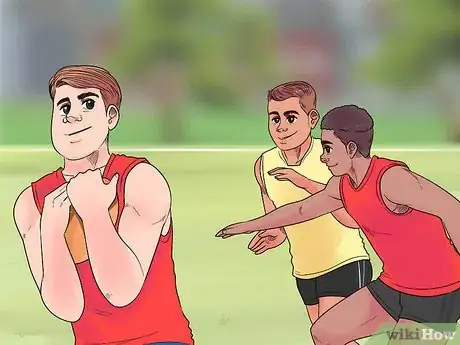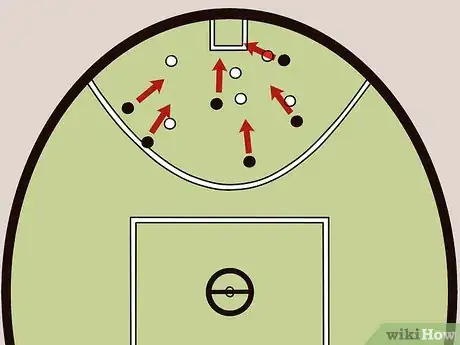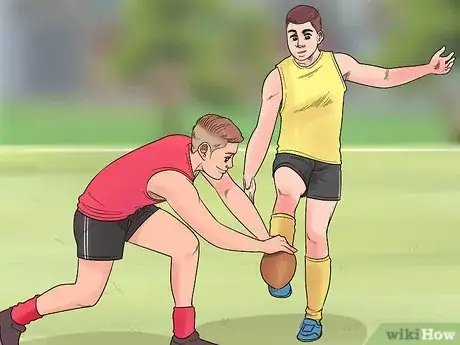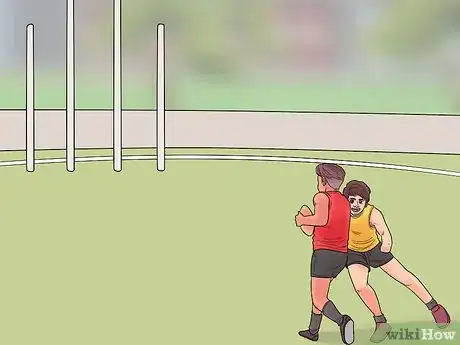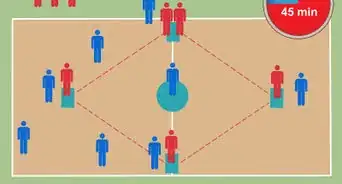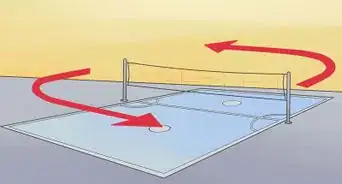This article was co-authored by wikiHow Staff. Our trained team of editors and researchers validate articles for accuracy and comprehensiveness. wikiHow's Content Management Team carefully monitors the work from our editorial staff to ensure that each article is backed by trusted research and meets our high quality standards.
This article has been viewed 18,025 times.
Learn more...
One of the most loved and popular sports in Australia is Australian football, also commonly called "footy" or "Aussie rules". It has two teams of eighteen players each, with the aim of the game being to win the most points by kicking the football into the other team's goal posts. It's a fun contact sport that’s easy enough to play once you understand the rules of the game.
Steps
Following the Basic Rules
-
1Play the game on an oval field. The football pitch is split into three parts: Forward, Midfield, and Defence.[1] Each team will have 6 of their players in each part of the field, making 18 people on the field at all times, not counting any umpires.
- Cricket fields can usually double as pitches for Australian football, as they are usually similar sizes at around 180 meters (591 ft) in long and 150 meters wide. [2]
- Set up four tall posts (3 to 6 meters tall) that are around 6.4 meters (21 ft) apart at either end of the pitch that will serve as your scoring zones. The two center posts should be taller than the ones on either end
-
2Start the game with a ball-up. Also called a ruck, the game starts with an umpire tossing the ball up in the center of the field, otherwise known as the centre square. A player dedicated from either team will then jump higher in order to pass the ball to their own teammates (similar to a jump ball in basketball.) [3]
- The ball is passed between players by tossing it. Overhand passing isn't allowed. [4]
Advertisement -
3Kick the ball into the goal posts to score. Goals are worth 6 points and they’re scored when a player kicks the ball between the opposing team's two middle posts. The end posts are for behinds, which are worth one point.
- A behind means that the football passed the two behind posts in any other way. This can be if it hits a goal post, is deflected by another player through the posts, or goes between a long and a short goal post. [5]
Assigning Positions
-
1Pick strong, fast players your Forwards. The Forward positions are Full-Forward, Forward Pocket, Half-Forward, and Centre Half-Forward. For these positions, you’ll want to choose bigger, stronger, and more agile players.
-
2Choose good runners for the Midfielders. Midfielders are always in the middle part of the pitch. They'll need to be slightly more versatile and help out both Forwards and Defenders.
- The positions in Midfield include: the Wing (runs the ball up the field), the Ruck (stays close to the ball), the Ruck-Rover (participates in the ball-up), the Rover (applies pressure to the other team), and the Centre (works with all other players). [8]
- Pick tall people to be the Rucks.
-
3Choose agile players for Defenders. These players will be closest to the goal posts. Their job is keeping the opposing team from scoring any goals or behinds.
- The positions include Full-Backs (defends their zone), Back Pockets (keeps opposing team from getting the ball), Half-Backs (mostly defensive, but takes the ball if they can), and Centre Half-Back (must out muscle the opposing Centre Half-Forward). [9]
-
4Pick level headed people to be umpires. In Australian Football, there are 7 umpires in total. They have a job similar to referees, where their objective is to keep the game moving smoothly. Any statement made by an umpire is final.
- There 3 main umpires oversee timekeeping and infringements on rules, two who make note of the ball going out of bounds, and the last two who will see whether a goal has been scored or not. [10]
Playing Forward
-
1Mark the ball. A mark is when a player catches the ball after it's been kicked in the air over 15 meters (49.2 ft) away by another player. After the mark happens the match will come to a short pause as the player is about to kick the ball from where they marked. [11]
- A player can't be tackled when they are preparing to kick the ball after a mark. The match starts again once the ball has been kicked.
-
2Tackle other players. Australian football is definitely a contact heavy sport. Players can tackle each other from the shoulder down, but tackles are not permitted from the back. [12]
-
3Shepherd players on the opposing teams. Forwards can shepherd other players to get them away from the ball. This can be done by pushing them in the chest or side, or by placing your body between the opposition and the ball. [13] It’s a good technique to confuse the other player before they have time to get the ball, allowing one of your one teammates to retrieve it instead.
- Shepherding can only be done when the ball is less than five meters away.
-
4Overload the Defenders zone. Players on offense, or Forwards, will want to overwhelm the opposing Defenders by taking over the opposing team's "danger zone" (the zone closest to the goal posts.) [14] This way the Defenders will lose track of the opposing players in their zone and it’ll be easier for the Forwards to score a goal.
Playing Defense
-
1Stop the other team from scoring goals. This is the main job of the Defenders, hence their name. The “danger zone” implies the zone that the Defenders are trying to protect by tackling the Forwards that make it there.
-
2Do person to person defense. With person to person defense, you're to focus on a specific player, similar to basketball. If this player has the ball, you've got to try to stop them from getting it closer to your goal posts or from passing the ball to another player on the opposing team.
-
3Perform zone defense. In zone defense, players will have to defend an area rather than focusing on a specific person. [15] This is similar to soccer, where there isn't really any person to person defense. Australian football is unique in that it uses both types of defense.
References
- ↑ https://aflfootballcoaching.weebly.com/player-positions.html
- ↑ http://www.rulesofsport.com/sports/aussie-rules-football.html
- ↑ http://www.rulesofsport.com/sports/aussie-rules-football.html
- ↑ https://usafl.com/intro
- ↑ https://usafl.com/intro
- ↑ https://aflfootballcoaching.weebly.com/player-positions.html
- ↑ https://aflfootballcoaching.weebly.com/player-positions.html
- ↑ https://aflfootballcoaching.weebly.com/player-positions.html
- ↑ https://aflfootballcoaching.weebly.com/player-positions.html
- ↑ http://www.rulesofsport.com/sports/aussie-rules-football.html
- ↑ tutorialspoint.com/australian_football/how_to_play_australian_football.htm
- ↑ http://www.rulesofsport.com/sports/aussie-rules-football.html
- ↑ https://usafl.com/intro#shepherding
- ↑ https://www.slideshare.net/zmcdonal/australian-rules-football-tactics
- ↑ https://aflfootballcoaching.weebly.com/player-positions.html
- ↑ http://www.rulesofsport.com/sports/aussie-rules-football.html
